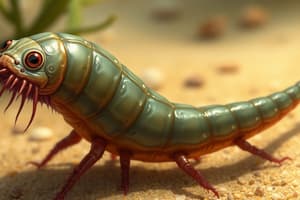Podcast
Questions and Answers
What phylum does class Trematoda belong to?
What phylum does class Trematoda belong to?
Platyhelminthes
What are the three subclasses within class Trematoda?
What are the three subclasses within class Trematoda?
- Subclass Digenea (correct)
- Subclass Aspidogastrea (correct)
- Subclass Monogenea (correct)
- Subclass Nematoda
Where is Subclass Monogenea commonly found?
Where is Subclass Monogenea commonly found?
Amphibians and fish
What types of animals are associated with Subclass Aspidogastrea?
What types of animals are associated with Subclass Aspidogastrea?
What is significant about Subclass Digenea?
What is significant about Subclass Digenea?
What are the general characteristics of class Trematoda?
What are the general characteristics of class Trematoda?
What type of reproduction occurs in the definitive host for Trematodes?
What type of reproduction occurs in the definitive host for Trematodes?
What are some morphological characteristics of adult Trematodes?
What are some morphological characteristics of adult Trematodes?
Describe the morphology of the Trematode egg.
Describe the morphology of the Trematode egg.
What are the larval stages of Trematodes?
What are the larval stages of Trematodes?
What does the Miracidium stage do?
What does the Miracidium stage do?
What is the role of the Cercaria stage?
What is the role of the Cercaria stage?
What can adult Trematodes localize in?
What can adult Trematodes localize in?
Describe the indirect life cycle of Trematodes.
Describe the indirect life cycle of Trematodes.
What are the transmission methods for Nematodes and Trematodes?
What are the transmission methods for Nematodes and Trematodes?
Flashcards are hidden until you start studying
Study Notes
Class Trematoda (Flukes)
- Belongs to the phylum Platyhelminthes.
- Divided into three subclasses: Monogenea, Aspidogastrea, and Digenea.
Subclass Monogenea
- Primarily found in amphibians and fish.
Subclass Aspidogastrea
- Found in poikilothermic animals, including molluscs, sharks, and bony fishes.
Subclass Digenea
- Contains organisms significant to veterinary and human medicine.
- Approximately 40 million people globally are infected with at least one trematode.
- Livestock fluke infections result in millions of dollars lost annually in the USA.
General Characteristics
- Commonly referred to as flukes or flatworms; all are parasitic.
- Majority are hermaphroditic (monecious) except the family Schistosomatidae.
- Indirect life cycle, typically involving snails as intermediate hosts, with a second intermediate host possible.
- Larval stages can multiply asexually, enhancing parasite numbers.
- Asexual reproduction occurs in intermediate hosts, while sexual reproduction takes place in definitive hosts.
Morphology: Adult
- Acoelomate body structure with organs embedded in parenchyma.
- Digestive tract is primitive, consisting of a mouth and a blind gut (caeca).
- Suckers (acetabulum) used for attachment.
- Contains a single ovary and paired branched testes that empty into a central genital pore.
- Features a simple excretory and nervous system.
Morphology: Egg
- Eggs are operculated, featuring a lid-like structure.
- Miracidium larval stage develops within the egg.
- Eggs are dense, preventing them from floating.
Morphology: Larval Stages
- Sequence of larval stages includes Miracidium, Sporocyst, Redia, Cercaria, and Metacercaria.
Miracidium
- Ciliated and motile, it is a short-lived, free-swimming larva that hatches from the egg and penetrates the snail host.
Sporocyst
- Sac-like larval stage that reproduces asexually inside the snail, can be maternal or develop into daughter sporocysts.
Redia
- A larval stage evolving within the sporocyst that possesses a primitive sucker and multiplies asexually inside the snail.
Cercaria
- A motile larval stage that exits the snail into the water, capable of either penetrating another host (the definitive host) or encysting in the environment.
Metacercaria
- An encysted larval stage that is resistant to environmental factors and infective to the definitive host.
Adult Worm Localization
- Adult trematodes can inhabit various host tissues, including the liver, bile ducts, lungs, and blood.
Trematodes' Indirect Life Cycle
- Characterized by both sexual and asexual multiplication; one egg can lead to over 100 replicating larvae and numerous adults.
Nematode vs. Trematode Transmission
- Nematodes transmit via ingestion, skin penetration, and additionally through transplacental or transmammary routes.
- Trematodes primarily transmit through ingestion and skin penetration.
Studying That Suits You
Use AI to generate personalized quizzes and flashcards to suit your learning preferences.




